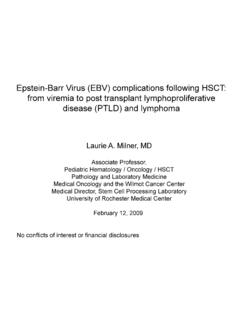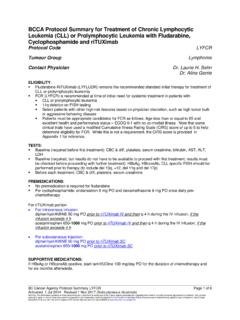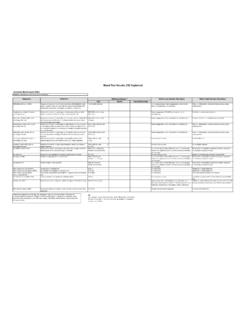Transcription of DRUG NAME: Fludarabine - BC Cancer
1 Fludarabine drug name : Fludarabine SYNONYM(S): 9-B-D-arabinofuranosyl-2-fluoroadenine 5 -monophosphate,1 FAMP,2,3 2-fluoro-ara-A Monophosphate,3 2-fluoro-ara-AMP,1,3 Fludarabine phosphate,1 NSC-3128871 COMMON TRADE name (S): FLUDARA CLASSIFICATION: antimetabolite1 Special pediatric considerations are noted when applicable, otherwise adult provisions apply. MECHANISM OF ACTION: Fludarabine phosphate is a synthetic fluorinated analog of the purine nucleoside antiviral agent vidarabine (ara-A).1,4 Unlike vidarabine, Fludarabine phosphate is resistant to deamination by adenosine Fludarabine phosphate is a water-soluble prodrug that is rapidly dephosphorylated to 2-fluoro-vidarabine (2F-ara-A). 2F-ara-A is actively transported into cells and is then rephosphorylated via deoxycytidine kinase to the active triphosphate derivative 2F-ara-ATP competitively inhibits DNA synthesis via inhibition of DNA polymerase, ribonucleotide reductase, DNA primase, and DNA ,5 2F-ara-ATP prevents elongation of DNA strands through direct incorporation into DNA as a false ,2 Partial inhibition of RNA polymerase II and resultant reduction in protein synthesis may also Cytotoxicity occurs primarily in the S-phase of cell division4; Fludarabine is also active against non-proliferating Fludarabine has been shown to induce apoptosis in ,6 PHARMACOKINETICS: IV and oral dosing provide similar systemic exposure6 Oral Absorption 50-75%2,6,7; dose-independant,6 unaffected by food8 widely distributed3 cross blood brain barrier?
2 No information found volume of distribution3 83-98 L/m2; suggests significant degree of tissue binding Distribution plasma protein binding no in vivo information found rapidly and completely dephosphorylated in plasma to 2-F-ara-A; pharmacokinetic data is based on 2F-ara-A active metabolite(s) 2F-ara-ATP Metabolism inactive metabolite(s)2,9 2F-ara-A, 2-F-ara-adenosinediphosphate minor: 2F-ara-hypoxanthine, 2-fluoro-vidarabine urine2 40-60%, 23% as 2-fluoro-vidarabine within 24 hours; renal elimination is dose-related: 24% at 25mg/m2/d, 40-60% at higher doses3,10 feces no information found terminal half life3 15-23 h children3,10: h Excretion clearance 79 mL/min/m2; directly correlates with creatinine clearance Adapted from standard reference1 unless specified otherwise.
3 BC Cancer Agency Cancer drug Manual Page 1 of 10 Fludarabine Developed: September 1994 Revised: February 2007, 1 June 2013, 1 September 2013 Fludarabine USES: Primary uses: Other uses: *Leukemia, chronic lymphocytic Conditioning regimen pre-allogeneic bone marrow transplant2 Leukemia, prolymphocytic3 Leukemia, acute myeloid5 *Lymphoma, non-Hodgkin s Leukemia, hairy cell3,7 Lymphoma, cutaneous T-cell3,7 Waldenstrom s macroglobulinemia3,7 *Health Canada approved indication SPECIAL PRECAUTIONS: Contraindicated in patients who have a history of hypersensitivity reactions to Fludarabine or any components of the formulation, in renally impaired patients with a creatinine clearance less than 30 mL/minute, and in patients with decompensated hemolytic Caution: Use Fludarabine with caution in patients with severe impairment of bone marrow function, immunodeficiency, or a history of opportunistic Potentially life-threatening transfusion-related graft-versus-host-disease can occur in patients with severe lymphopenia; patients receiving Fludarabine should receive irradiated blood products, effectively eliminating this Concomitant therapy with corticosteroids and Fludarabine increases the risk of infections with opportunistic pathogens such as Pneumocystis, Listeria, and cytomegalovirus7,11; the combination should be High doses of Fludarabine (>96 mg/m2/day for 5-7 days) have been associated with severe irreversible central nervous system toxicity characterized by delayed progressive encephalopathy with seizures, blindness, paralysis, coma, and death1,12.
4 Severe neurotoxicity has rarely occurred at recommended Hepatitis B (HBV) reactivation: All lymphoma patients should be tested for both HBsAg and HBcAb. If either test is positive, such patients should be treated with lamivudine 100 mg/day orally, for the entire duration of chemotherapy and for six months afterwards. Such patients should also be monitored with frequent liver function tests and HBV DNA at least every two months. If the hepatitis B virus DNA level rises during this monitoring, management should be reviewed with an appropriate specialist with experience managing hepatitis and consideration given to halting ,14 Special populations: Because geriatric patients may have decreased renal function, and patients with renal impairment may be at increased risk of Fludarabine -induced toxicity, these patients should be monitored and dosage adjusted Geriatric patients with advanced Rai stage chronic lymphocytic leukemia may require substantial dosage Carcinogenicity: no information found3 Mutagenicity: Not mutagenic in Ames test and mammalian in vitro mutation test.
5 Fludarabine is clastogenic in mammalian in vitro and in vivo chromosome ,3 Fertility: No long term studies have been performed in men or women to determine the effect on fertility. Patients of reproductive potential should use effective contraceptive methods during treatment and for a minimum of 6 months following Fludarabine Pregnancy: FDA Pregnancy Category There is positive evidence of human fetal risk, but the benefits from use in pregnant women may be acceptable despite the risk ( , if the drug is needed in a life-threatening situation or for a serious disease for which safer drugs cannot be used or are ineffective). Breastfeeding is not recommended due to the potential secretion into breast BC Cancer Agency Cancer drug Manual Page 2 of 10 Fludarabine Developed: September 1994 Revised: February 2007, 1 June 2013, 1 September 2013 Fludarabine SIDE EFFECTS: The table includes adverse events that presented during drug treatment but may not necessarily have a causal relationship with the drug .
6 Because clinical trials are conducted under very specific conditions, the adverse event rates observed may not reflect the rates observed in clinical practice. Adverse events are generally included if they were reported in more than 1% of patients in the product monograph or pivotal trials, and/or determined to be clinically When placebo-controlled trials are available, adverse events are included if the incidence is > 5% higher in the treatment group. ORGAN SITE SIDE EFFECT Clinically important side effects are in bold, italics anaphylaxis (<6%)3,4 allergy/immunology autoimmune reactions; Evans syndrome, pemphigus5 auditory/hearing hearing disturbances (<6%)3; loss, auditory hallucinations anemia (35%, severe 7-24%)4,16,17 autoimmune hemolytic anemia (<1-23%)4,5,17; has occurred after initial or subsequent dosing,3,7 see paragraph following the Side Effects table immunosuppression11; lymphopenia, leukopenia (severe 28%)16 neutropenia (15-75%, severe 19-54%)3,11,17,18; dose-related, nadir day 13 (range 3-25), complete recovery typically occurs 5-7 weeks after treatment2,3 autoimmune neutropenia5 myelodysplastic syndrome (< ); duration may be prolonged, up to 1 year2 pancytopenia3,5; durations of 2 months to 1 year have been reported3 blood/bone marrow/ febrile neutropenia thrombocytopenia (32%, severe 14-26%)16,17.
7 Nadir day 16 (range 2-32), complete recovery typically occurs 5-7 weeks after treatment2,3 autoimmune thrombocytopenia5 cardiovascular (arrhythmia) arrhythmia (< ) angina (<6%)3 heart failure (< ) cardiovascular (general) pericardial effusion coagulation thrombocytopenic purpura; idiopathic and thrombotic19 chills (1%- >10%)2 fatigue (1%-38%)2,3 fever (>10%)2; with iv,15 unrelated to infection sweating (<13%)3 constitutional symptoms sleep disorder (<3%)3 extravasation hazard: none20 alopecia (1-10%, severe <1%)2,16,17,21 pruritis (<5%)3,16 rash (<15%)2,3,16 reversible worsening or flare of pre-existing skin Cancer lesions22 seborrhea (<5%)3 dermatology/skin Stevens-Johnson syndrome, toxic epidermal necrolysis (< ) BC Cancer Agency Cancer drug Manual Page 3 of 10 Fludarabine Developed: September 1994 Revised: February 2007, 1 June 2013, 1 September 2013 Fludarabine BC Cancer Agency Cancer drug Manual Page 4 of 10 Fludarabine Developed: September 1994 Revised: February 2007, 1 June 2013, 1 September 2013 ORGAN SITE SIDE EFFECT Clinically important side effects are in bold, italics emetogenic potential: rare23 anorexia (<34%)3 constipation (<5%)3 dysphagia (<5%)3 diarrhea (5%-38%, severe 1-5%)3,16,17.
8 More frequent with oral formulation16 intestinal pseudo-obstruction5 mucositis (<5%)3, stomatitis (<9%)3, esophagitis (<5%)3 nausea and vomiting (<39%, severe <1%)3,16,17,21; generally mild,3 more frequent with oral formulation16 gastrointestinal taste alterations3 (<1%)2 epistaxis (<5%)3 gastrointestinal bleed (<13%) hemoptysis (<6%)3 hemorrhage hemorrhage (<6%)3 liver dysfunction (<6%)3 hepatobiliary/pancreas pancreatitis3 infections (<77%, severe <35%)3,11; see paragraph following the Side Effects table pneumonia (9-22%)2,3 upper respiratory infections (2%-16%)5 infection urinary tract infection (<15%)3 lymphatics edema (<19%)2,3 abnormal liver function tests (<6%)3,4 abnormal renal function tests (1%)4 hyperglycemia (<6%)3 hyperuricemia3; see syndromes metabolic/laboratory pancreatic enzyme level changes (<1%) osteoporosis (<6%)3 musculoskeletal weakness (<65%)2,3 cerebellar syndrome3 cognitive disturbances3; agitation (<1%), confusion (<1%) coma (< ) dizziness3 depression3 leukoencephalopathy (< ); higher incidence (36%) associated with high-dose,11 onset typically 4-8 months after treatment5 neurology neurotoxicity (16%)21; onset typically 21-60 days after treatment,3,11 see paragraph following the Side Effects table Fludarabine BC Cancer Agency Cancer drug Manual Page 5 of 10 Fludarabine Developed: September 1994 Revised: February 2007, 1 June 2013, 1 September 2013 ORGAN SITE SIDE EFFECT Clinically important side effects are in bold, italics sensory neuropathy (<12%, severe <1%)2,3,17 seizure (< ) wrist drop3 blindness (< ) optic neuropathy (< ), optic neuritis (< ) photophobia (<1%).
9 Primarily at higher doses2 ocular/visual visual disturbances (<15%)3; blurred vision, diplopia (<1%)2 dysuria headache (1-10%)2,3 myalgia (<16%),2,3 arthralgia (<6%)3 pain pain not otherwise specified (<44%)2,3 cough (<44%)3 dyspnea (<22%)3 pharyngitis (<9%),3 bronchitis and sinusitis (<5%)3 pulmonary pulmonary hypersensitivity reactions; pneumonitis, pulmonary infiltrates, fibrosis (<5%)3; onset typically 3-28 days after the third or later treatment,3 see paragraph following the Side Effects table hemorrhagic cystitis (< ) renal failure (<1%)2 renal/genitourinary urinary hesitancy (<5%)3 hemophagocytic syndrome5 syndromes tumour lysis syndrome3 ( )2,5 Adapted from standard reference1 unless specified otherwise. Neurotoxicity: Severe and potentially irreversible or fatal neurotoxicity has occurred with Fludarabine . While these effects typically occur with doses higher than those recommended, they have occurred at standard ,3 Neurotoxicity generally occurs 21-60 days following Fludarabine and may cause confusion, incontinence, seizures, paralysis, vision changes, and ,3 At regular doses, neurotoxicity is generally mild and may be reversible,21 causing headache, somnolence, agitation, confusion, and paresthesias.
10 Rarely, coma and seizures have The mechanism by which Fludarabine causes neurotoxicity is It is not known if the rate of drug administration affects the risk of neurotoxicity; neurotoxicity has been reported with rapid IV injections and slow IV If vision changes occur, discontinue Fludarabine Immunosuppression / opportunistic infections: Patients are at risk for opportunistic infections due to the T-cell lymphopenia, particularly of CD4 cells, induced by ,11 Lymphopenia develops within 2-3 months and the decrease in CD4 cells may persist for years following In patients treated with Fludarabine , up to 67% of infections are caused by opportunistic Delayed and/or severe opportunistic infections may occur, particularly after repeated cycles of Concomitant therapy with corticosteroids increases the risk of opportunistic infections and the combination should be Routine anti-infective prophylaxis or immune globulin use is not currently recommended but may be considered for high risk If a serious infection occurs, Fludarabine therapy should be interrupted but may be reinitiated following the resolution of the infection.

















